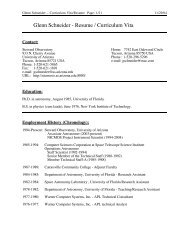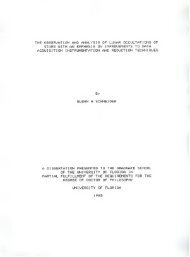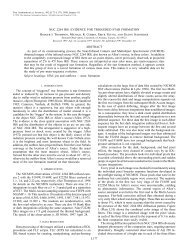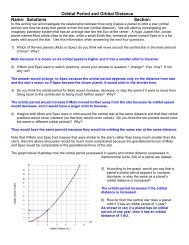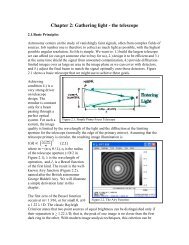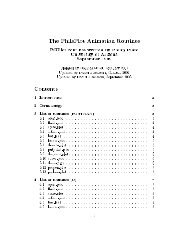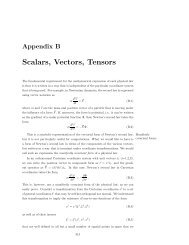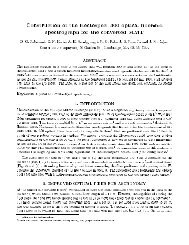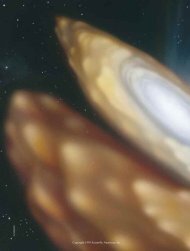ASTROPHYSICAL APL - DIAMONDS IN THE SKY
ASTROPHYSICAL APL - DIAMONDS IN THE SKY
ASTROPHYSICAL APL - DIAMONDS IN THE SKY
Create successful ePaper yourself
Turn your PDF publications into a flip-book with our unique Google optimized e-Paper software.
The Runge-Kutta integration is invoked by WHlTEDWARF[l l]using the established boundary values. On completion,RUNGKUT will pass the results of its integration from thelower boundary to the surface back to WHITEDWARF. Thevalues in the last row of the matrix passed by RUNGKUT aremeaningless, since this corresponds to some small distanceoutside of the stellar interior. Hence, this row is dropped byWHlTEDWARF[ 121. The structure matrix, then, runs from thelower boundary to as close to the surface as the integrationstep, Ar, allows without stepping out of the interior. Thisregion, under the surface, can be taken as a new lowerboundary, and the integration process may be iterated to get toas close to the surface as desired. WHITEDWARF[13] has beenset up to decrease Ar by a factor of 10 when the Runge-Kuttaintegration is repetitively invoked to closely approach thesurface. The left argument of WHITEDWARF, E, specifies theending value of Ar , for terminating the white dwarf model.The <strong>APL</strong> realization of this physical model is short, concise,and easily understood. The question of what represents “goodprogramming style” in <strong>APL</strong> has been discussed almostendlessly in the literature. The argument has been made thatsome <strong>APL</strong>ers tend to “one-1inerize”. combining unrelated anddisjointed thoughts into a single executable line for the sakeof creating artificial brevity of expression. Sadly, this is true.Such practices have been perpetrated by well intentioned, butoften unthinking <strong>APL</strong>ers, in attempts to win over or impressthose unacquainted with <strong>APL</strong> of its notative compactness.This invariably leads to slanderous, but not always undeservedcomments about “those unreadable chicken scratches”, or theinevitable “looks like Greek to me” remarks.At the other extreme is the notion that <strong>APL</strong> statements must bebroken down into short segments to enhance readability (<strong>APL</strong>Quote Quad, 1985). This typically involves the arbitraryinclusion of ultimately vestigial linguistic constructs whichserve only to cloud the thoughts enveloped in the <strong>APL</strong>expression of the problem as discussed by Berry and Pesch(1986). “Enhancing” the readability of the code byincorporating unnecessary assignment statements andadditional name references is akin to paying an author by theword rather than for his or her words. In the development oflarge software systems, it is not uncommon for progress to bemeasured by the number of lines of executable code. Do wereally want this sort of outlandish situation in <strong>APL</strong>?As a tool of thought a computer language should not imposeartificial linguistic or stylistic constraints on the thinker. Thethought processes which are implicitly mapped into the codeshould not be obscured by “enhancement”, either bylengthening or shortening the notative representation of theproblem at hand. We believe that as a case in point the whitedwarf model presented here illustrates this, and the concept that“<strong>APL</strong> possesses certain important characteristics which speeddevelopment and assist thought” (Bemecky, 1986).In developing our <strong>APL</strong> model of white dwarf stars we made noeffort to either “one-linerize”, or to break up logicallyconnected thoughts to, as suggested by some, aid’ in thereadability of the code. On the contrary, just as each functionrepresents a modular piece of the solution, in a hierarchialsense, each function line represents a discrete “chunk” ofthinking.NUMERICALRESULTSAs with any numerical integration scheme, the precision of thesolution depends upon the granularity of the integration step.We have found that WHITEDWARF will return meaningfulresults even with relatively coarse initial integration steps.As an example, Table 1 shows the actual results obtained fromrunning WHITEDWARF with the input parameters indicated.Here, with 100 km (lE7 cm.) initial integration steps, thetotal stellar mass was found to be within 1% of the “true”value, as indicated by center-to-surface runs with integrationsteps 1000 times smaller.The Fist three terms in the table, RCl, RC2, and RC3 are thedimensionless values of the relativistic correction factorsincorporated in the GTR equation of hydrostatic equilibrium(the vector, r, in DES[2]). As anticipated, all three converge tounity as the surface of the star is approached. Similarly, therelativity parameter, X, approaches zero near the surface whereonly mild partial degeneracy exists. An examination of theincrementing radius indicates that the surface boundary wasfirst crossed between 1.1~10~ and 1.2~10~ cm.WHITEDWARF[3] then reduced the size of the integration stepby a factor of 10 (to lo6 cm.) and re-entered the Runge-Kuttaintegration from the subsurface region. The surface boundarywas again crossed between 1.30x10* and 1.31~10~ cm.WHITEDWARF then terminated since the last value of Ar wasthe same as the terminal value specified by the left argument.Table 1.Sample Run: 1 E6 WHITEDWARF 12 1 El0 2 1 E7EcLIGLluzLxormPO.OOEOO O.OOEOl O.OOEOl 0.00 l.OElO l.OOEl 4.19E13 1.04E261.00101 1.00274 1.00047 17.25 6.77E9 l.OOE7 3SlE31 6.71E271.00097 1.00223 1.00194 15.15 5.97E9 2.00E7 2.54E32 6.04E271.00066 1 .00174 1.00346 14.53 4.16E9 3.00E7 6.79E32 3.44E271.00072 1 .00116 1.00456 12.69 2.50E9 4.00E7 1.20E33 1.69E271.00059 1.00073 1.00514 10.67 1.36E9 5.00E7 1.66E33 7.57E261.00047 1.00042 1.00525 6.67 6.95E6 6.00E7 2.07E33 3.17E261.00036 1.00022 1.00506 7.09 3.42E6 7.00E7 2.35E33 1.26E261.00026 1 .OOOl 1 1.00477 5.60 1.61 E6 6.OOE7 2.53E33 4.76E251.00021 1.00005 1.00442 4.36 7.11 E7 9.00E7 2.65E33 1.67E251 .00014 1.00002 1.00406 3.32 2.74E7 l.OOE6 2.71E33 5.23E241.00006 1 .ooooo 1.00373 2.42 6.65E6 l.lOE6 2.74E33 1.37E24O.OOEOO O.OOEOl O.OOEOO 0.00 6.65E6 l.lOE8 2.74E33 1.37E241.00010 1.00001 1.00368 1.51 1.27E7 l.llE6 2.74E33 1.17E241 .OOOl 0 1 .OOOO 1 1.00365 1 .a7 1.13E7 1.12E6 2.74E33 9.67E231.00009 1 .OOOOl 1.00362 1.60 l.OlE7 1.13E6 2.75E33 6.32E231.00009 1.00001 1.00359 1.73 8.92E6 1.14E6 2.75E33 6.96E231.00006 1 .OOOOO 1.00356 1.66 7.66E6 1.15E6 2.75E33 5.76E231.00006 1.00000 1.00353 1.59 6.69E6 1.16E6 2.75E33 4.76E231.00007 1 .ooooo 1.00350 1.52 6.00E6 1.17E6 2.75E33 3.69E231.00007 1 .ooooo 1.00346 1.46 5.20E6 1.16E6 2.75E33 3.14E231.00006 1 .OOOOO 1.00345 1.39 4.47E6 1.19EB 2.75E33 2.51 E231.00006 1 .OOOOO 1.00342 1.32 3.61 E6 1.20E6 2.75E33 1.97E231.00005 1 .OOOOO 1.00339 1.25 3.22E6 1.21E8 2.75E33 1.53E231.00005 1 .ooooo 1.00337 1.16 2.68E6 1.22E8 2.76E33 1.16E231.00004 1 .ooooo 1.00334 1.11 2.20E6 1.23E6 2.76E33 6.59E221.00004 1 .ooooo 1.00331 1.04 1.78E6 1.24E6 2.76E33 6.16E221.00003 1 .OOOOO 1.003?9 0.97 1.41 E6 1.25E6 2.76E33 4.29E221.00003 1 .OOOOO 1.00326 0.90 1.08E6 1.26E6 2.76E33 2.63E221.00002 1 .OOOOO 1.00323 0.62 7.94E5 1.27E6 2.76E33 1.75E221.00002 1 .OOOOO 1.00321 0.74 5.53E5 1.26E6 2.76E33 9.66E211.00001 1.00000 1.00318 0.66 3.50E.5 1.29E6 2.76E33 4.61 E211 .OOOOl 1 .OOOOO 1.00316 0.56 1.85E5 1.30E6 2.76E33 1.61 E211.00000 1.00000 1.00314 0.46 4.56E4 1.31 E6 2.76E33 4.08E20<strong>APL</strong> QUOTE QUAD 309Schneider, Paluzzi and Webb




